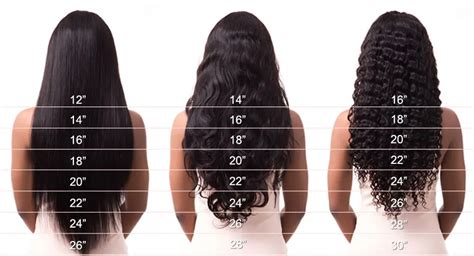Are you curious about the length of your hair? Do you want to track its growth or compare it to others? The hair inch chart is an invaluable tool for measuring your tresses with precision. This comprehensive guide delves into everything you need to know about the hair inch chart, from its uses to measuring techniques and common mistakes to avoid.

What is a Hair Inch Chart?
A hair inch chart is a visual representation of hair lengths from the scalp to the tips. It’s usually printed on a ruler or measuring tape, with each inch of hair represented by a set of lines or markings. The chart allows you to accurately measure your hair length, which can be useful for tracking growth, choosing the right hairstyles, or communicating with your hairstylist.
How to Measure Your Hair Length
Measuring your hair length with a hair inch chart is straightforward:
- Place a hair inch chart at the base of your scalp, holding it taut.
- Comb your hair straight to remove any tangles or curls.
- Gently pull your hair down over the chart until the tips align with one of the lines.
- Read the number corresponding to the line where the hair tips rest to determine your hair length in inches.
Interpreting the Hair Inch Chart
Once you’ve measured your hair length, it’s important to interpret the results correctly:
- Hair Inch: The length of your hair from the scalp to the tips in inches.
- Hair Length Category: Different hair lengths are typically classified into categories, such as short (0-8 inches), medium (8-14 inches), long (14-22 inches), and extra long (over 22 inches).
- Hair Growth Rate: According to the American Academy of Dermatology, hair grows at an average rate of 0.5-1.5 inches per month. By measuring your hair length over time, you can track your growth rate and identify any factors that may be affecting it.
Uses of the Hair Inch Chart
The hair inch chart has numerous applications:
- Tracking Hair Growth: Measure your hair length regularly to monitor its growth and identify any changes or trends.
- Choosing Hairstyles: Determine the length of hair required for certain hairstyles to help make informed decisions about your next cut.
- Communicating with Hairstylists: Clearly convey the desired hair length to your hairstylist using the hair inch chart measurements.
- Hair Extensions: Match the length of hair extensions to your existing hair length for a seamless blend.
Common Mistakes to Avoid
To ensure accurate hair length measurements, avoid these common pitfalls:
- Measuring Wet Hair: Water can temporarily elongate hair, leading to inaccurate readings. Measure your hair when it’s dry or slightly damp.
- Pulling Hair Too Tightly: Excessive tension can stretch your hair and provide a false impression of greater length.
- Using a Damaged Chart: A torn or faded hair inch chart can compromise the accuracy of your measurements.
- Guessing: Always use a hair inch chart for precise measurements. Guessing can result in inaccurate hair length estimates.
Table 1: Hair Length Categories
| Hair Length | Range (Inches) |
|---|---|
| Short | 0-8 |
| Medium | 8-14 |
| Long | 14-22 |
| Extra Long | Over 22 |
Table 2: Hair Growth Rate
| Age Group | Average Growth Rate (Inches per Month) |
|---|---|
| Children (6-12 years) | 0.5-1 |
| Adolescents (12-18 years) | 1-1.5 |
| Adults (18+ years) | 0.5-1.5 |
Table 3: Hair Length for Common Hairstyles
| Hairstyle | Hair Length (Inches) |
|---|---|
| Pixie Cut | 2-4 |
| Bob Cut | 6-10 |
| Long Bob (Lob) | 10-14 |
| Shoulder-Length | 12-16 |
| Mid-Back Length | 16-20 |
| Waist-Length | 20-24 |
| Hip-Length | 24-28 |
| Tailbone-Length | 28+ |
Table 4: Hair Extensions Length Matching Guide
| Hair Length (Inches) | Extension Length (Inches) |
|---|---|
| 8-12 | 12-16 |
| 14-18 | 18-22 |
| 20-24 | 24-28 |
| 26-30 | 30-34 |
| Over 30 | 36+ |
Conclusion
The hair inch chart is an indispensable tool for accurately measuring your hair length, empowering you to track growth, choose hairstyles, and communicate with hairstylists effectively. By following the techniques outlined in this guide and avoiding common pitfalls, you can consistently obtain precise hair length measurements.
